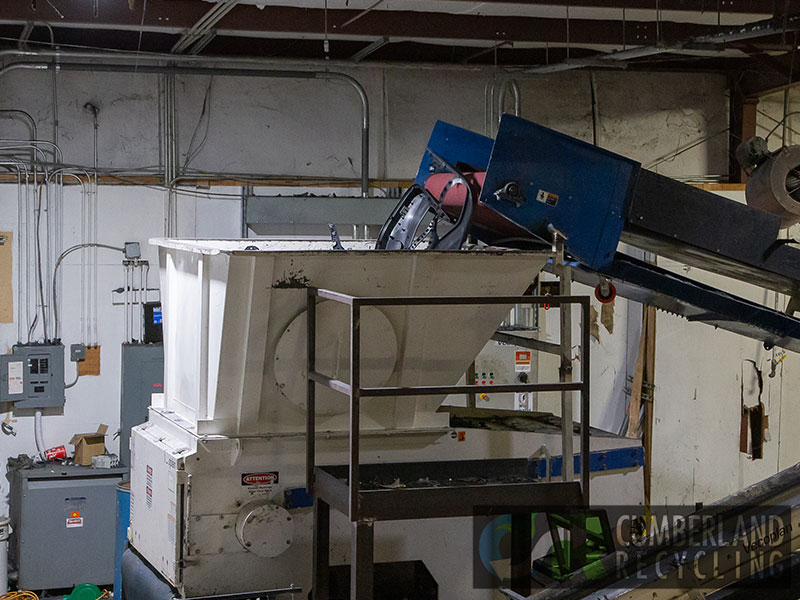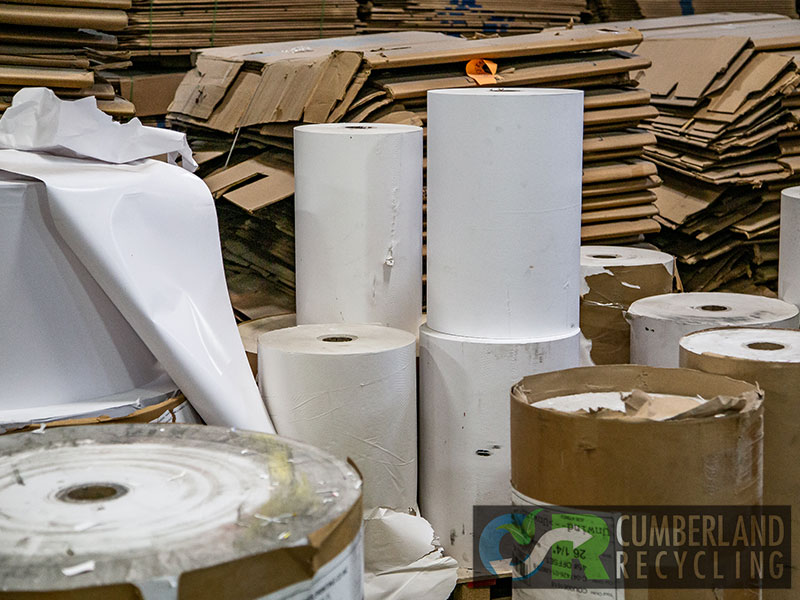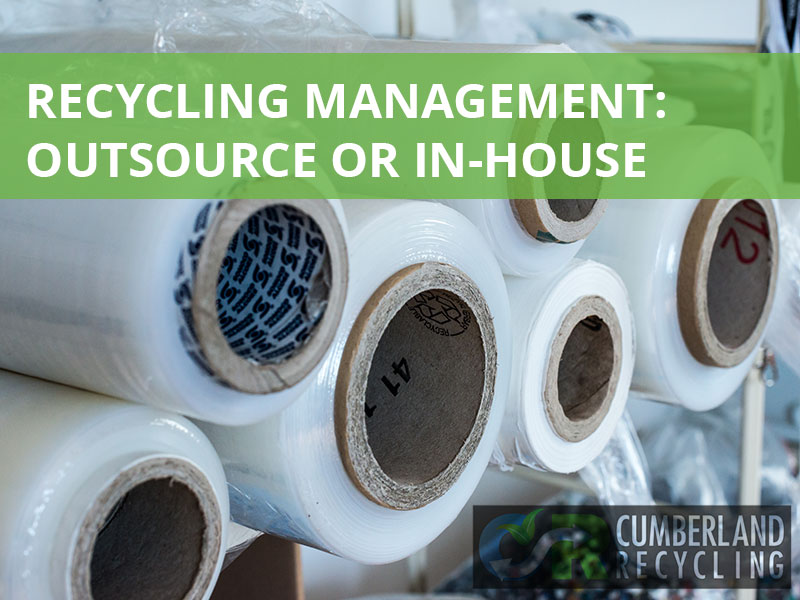This document will examine the pros and cons of your recycling management program and keeping it in-house with existing staff or handing them off to a third party.
Recycling: A Brief History
For as long as arrowheads have been reused by our ancestors, recycling has been with us.
However, it has evolved from its primitive beginnings to the advanced state we find today. After the Roman Empire collapsed, medieval Europe had less access to new goods than it once enjoyed. To this day, archeologists and historians continue to discover the remains of roman materials in Christian churches throughout Britain. Similarly, tile, ceramics, pottery, and iron were all reclaimed and repurposed.
Fast forward to the late 19th and early 20th Century and the emergence of the rag-and-bone man. These individuals ran regular routes collecting primarily textiles, metals, and bone. Rags would become paper; metals were smelted into new machine parts while the bone was boiled to manufacture glues and fertilizer.
The mid-twentieth century saw rapid industrialization, and at the close of the Second World War, industry steadily replaced agriculture generating even more significant amounts of discards and manufacturing byproducts. Much of this, except for the most valuable metals, was typically landfilled as this was often the least expensive alternative.
By the end of the twentieth century, it was becoming more apparent that resources were not infinite, and the general public increasingly began insisting that the companies making the products that they bought had to not only provide high quality but needed to do so in a way that did not harm the environment.

Recycling Today
Recycling today has evolved into a vast network of collection, sorting, processing, and brokering
organizations supporting many commodities’ manufacturing and re-use. For the purposes of this paper, we will examine the most significant commodity streams recovered at scale in today’s manufacturing, assembly, and food packaging environment. These include cardboard, wood, plastic, and food waste. (To a lesser extent, metals and glass are recovered, but we will address these commodities in a forthcoming paper.)
- Cardboard – Generally the most abundant packaging material found in the manufacturing environment. It lends itself to multiple reuses until the fibers become too short to maintain the strength required.
- Wood – In the form of pallets and crates can form a significant percentage of waste for not only equipment and hard goods manufacturers but virtually all production businesses, as logistics moves almost everything on wooden pallets.
- Plastics – Both flexible and rigid are frequently generated from the inbound materials used in the manufacturing process—for example, stretch wrap, strapping, plastic drums, and containers. Plastics can also be a significant packaging byproduct, especially in the food and beverage business. Most recently, ocean plastics have captured the attention of an entire generation of consumers.
- Food waste – Like plastics, has ignited discussion among the community and civic-minded individuals looking to bridge the gap between excessive waste and food insecurity to Pope Francis’ commentary on climate and hunger.
Making the business case for recycling
According to the US EPA, recycling reduces the amount of waste sent to landfills and incinerators;
conserves natural resources such as timber, water, and minerals and prevents additional pollution by reducing the need to collect new raw materials.
For the economy, recycling increases economic security by tapping a domestic source of materials; and saving energy. For communities, recycling supports American manufacturing while conserving valuable resources; and creates jobs in the manufacturing industries in the United States.
Recycling is an essential economic driver, as it helps create jobs and tax revenues. The Recycling
Economic Information (REI) Report found that, in a single year, recycling and reuse activities in the
The United States accounted for 757,000 jobs, $36.6 billion in wages, and $6.7 billion in tax revenues. This equates to 1.57 jobs, $76,000 in wages, and $14,101 in tax revenues for every 1,000 tons of material recycled.
Increasingly consumers, investors, and B2B customers are demanding that businesses do a better job of managing their discards and byproducts from manufacturing. The past 15 years have witnessed increasing consumer and investor activism around improved environmental performance. Global names like Subaru, Unilever, and Patagonia have successfully built their brands around ecological performance.

Discussion: Self-manage or outsource
Assuming that your organization is either currently recycling or would like to begin or expand its
recycling, from a management perspective, there are several choices. We will examine the two
alternatives used most frequently: in-house management or third-party (outsourced) management. We will begin by defining what we mean by each.
In-house or self-managed programs are, essentially: a person or a team from within the
the organization is hired, or existing staff are designated, either at the plant level or, more broadly, at the corporate level, to oversee recycling management. The process can be extensive and includes deciding which discards are to be recycled – usually through a waste audit – including determining the respective volumes of each. Subsequent decisions will include where in the production process and how the waste segregation process should be performed, including the types of containers to maximize recovery, avoid contamination and manage worker safety considerations. This is followed by establishing the most economical and safe on-site storage and volume reduction, if possible. Finally, and very importantly, is identifying the end markets (essentially customers purchasing your byproduct) and vetting vendors (equipment providers and transporters) who will support the
program.
By contrast, outsourcing is the practice of contracting an outside organization to manage processes typically viewed as non-core to the company’s mission and goals or where exceptional capabilities are required beyond current staffing knowledge and/or capabilities. Generally, it’s a value question or one of efficiency: “Is this job important enough to justify the time and expertise of staff to accomplish it?” Or, said another way, “Can this responsibility be handled more efficiently by an outside party? Either way, it is a value calculation, i.e., what is the role’s value in terms of time and expertise compared to other responsibilities that an employee must perform?
Several questions must be answered to help point an organization in the right direction. While many considerations go into this decision, the three most important topics include resources (time, personnel, and expertise). Secondly, the size and value of the waste streams involved, and how many plants/facilities are in the portfolio? Finally, what are the most efficient alternatives available to your operation? There are likely other considerations that these questions will generate.
- Resources – Beginning or expanding (an existing) recycling program requires time and
increasing experience in matters ranging from market knowledge to logistics. In the past,
a supervisor or other entry-level manager often managed recycling, who could make time to explore the various collection choices, vendors, and end-markets for the byproducts and discards to be diverted. So, the questions of “who” will be responsible and “how much available time” will be committed to the project must be answered. - Qualifying Project Scope, partners, and markets – Understanding the marketplace, including where and how byproducts will be used, is critical to crafting an enduring program. Among the essential first steps is performing an initial analysis to determine amounts and byproduct quality for recovery. Choosing the correct partner/vendors can be difficult for organizations beginning or expanding their recycling programs. It is among the primary reasons given by those choosing to outsource their programs. For example, markets for cardboard, paper, and plastics were especially hard-hit in mid-2018 when China, the largest buyer of recycled products, pulled out of global markets. This resulted in a rapid decline in the value of both paper and plastic. Then record-low oil prices compounded downward pressure on plastics values. Knowing where to go and how to structure pricing to produce a fair and equitable contract with indexes that both parties can live with is critical to ensuring the success of a new or expanded recycling program. Losing partners is never easy. Losing them during severe market fluctuations can create an unrecoverable situation.
- Organizations generating more complex waste streams and byproducts, such as food processors and packagers, add an additional element of complexity. High-volume facilities must simultaneously navigate choices between high disposal costs and the risk associated with sanitation, environmental and health, and safety concerns before choosing between a donation, animal feed, anaerobic digestion (where available), and composting. Asking EH&S managers – whose training is regulatory in nature – to assume responsibility for locating markets and negotiating contracts is unlikely to yield the most desirable outcomes. Likewise, asking a procurement professional to take the role of the salesperson in the hope that they can successfully sell commodities on the open market is equally unlikely to meet with success. (Would any well-run company turn their procurement department over to the sales team?)
As recently as the 1990s, many companies that once had entire floors of their operations designated as “computer rooms” have today outsourced this function to cloud-based servers and IT professionals. Likewise, once managed internally, areas such as payroll, transportation, and various other services have been contracted to organizations with demonstrated expertise in that respective area, freeing up time and resources for personnel, managers, and workers alike.
On the Pro side: three reasons to consider outsourcing:
- No need to Hire Additional Employees – When outsourcing, a company pays a contractor, which saves time and money on everything from benefits to training.
- Access to a Larger Talent Pool – Depending on location, there may only be a small, local talent pool. This often means compromising on the expertise required. Many companies have found that outsourcing gives them access to talent otherwise unavailable. Where specialized help is needed, it often makes sense to expand your search.
- Lower Labor Cost – (see #1 above)
Cons of Outsourcing – Some considerations before taking the step:
- Lack of Control – Although direction can be provided regarding what needs to be accomplished, some immediate control is relinquished when outsourcing. There will be some adjustments required initially.
- Communication Issues – This doesn’t always come into play, but it’s one of the most significant potential drawbacks. Here are several considerations:
- Time zones: How does this match up with your business hours?
- Preferred methods of communication: Phone, email, instant messaging?
- Quality – Despite all the benefits of outsourcing, it is only a success if the quality expected is
delivered. Expectations need to be set clearly from the outset.
Conclusion
Organizations should reserve internal expertise for high-value, core-business applications
and look for opportunities to outsource processes whose value relative to production is less or where expertise in a given area is limited. For more information on outsourcing waste services, please get in touch with Cumberland Recycling today.

